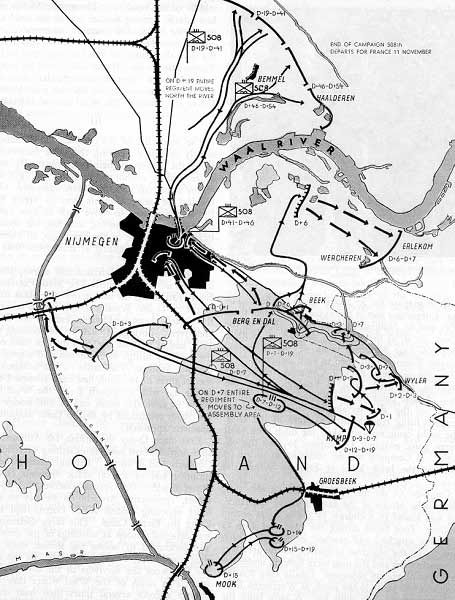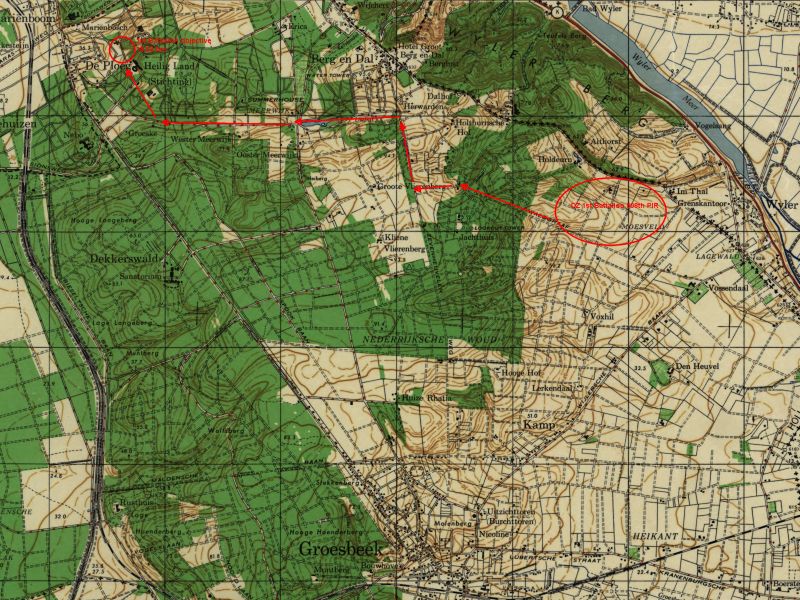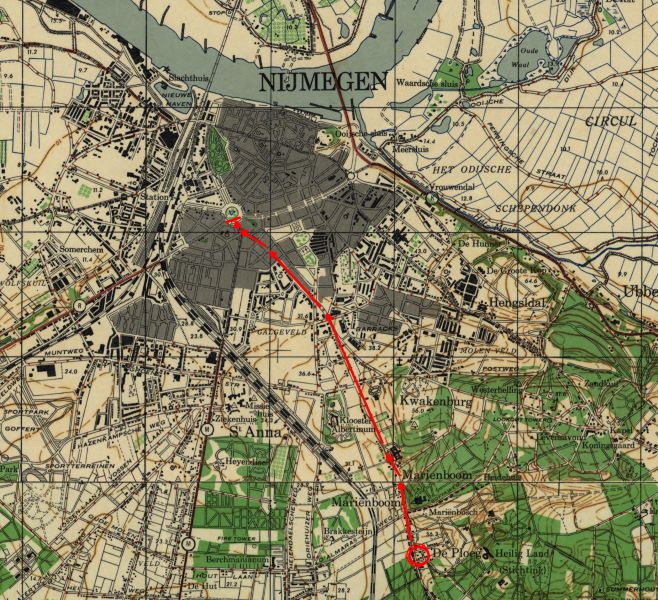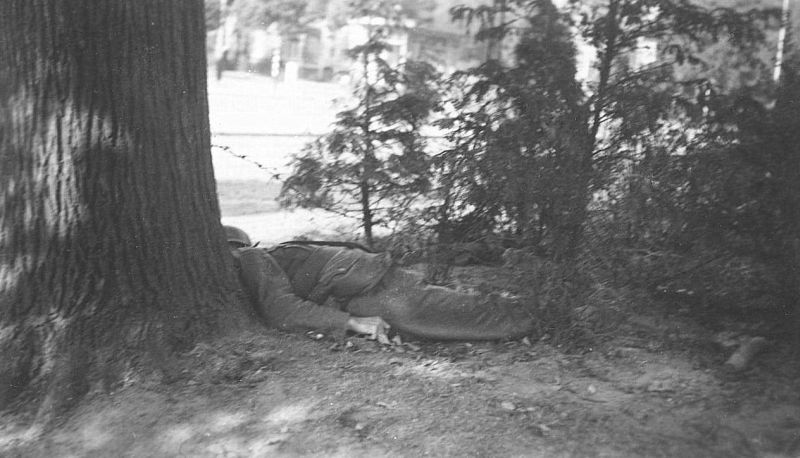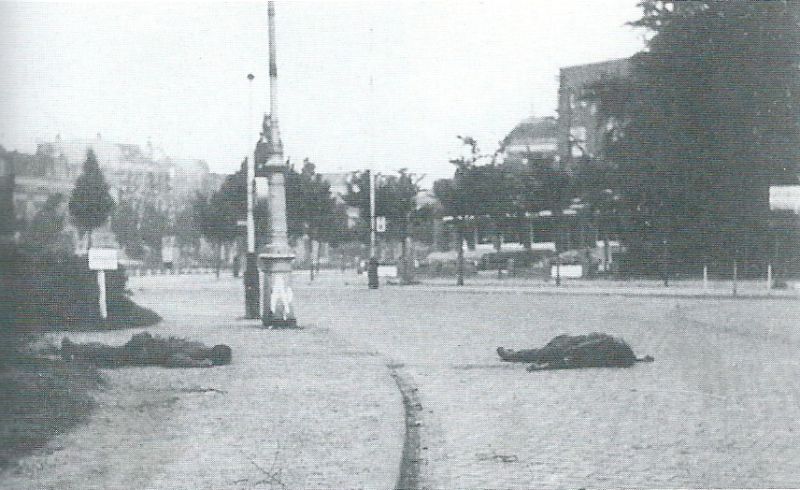Introduction
The capture of the various bridges across the rivers and canals in Mid-Holland was one of the most important assignments given to the three airborne divisions who were deployed during Market garden. Regarding the 82nd Airborne Division around Nijmegen, the railroad bridge across the Meuse at Grave, the bridges across the Meuse-Waal canal at Mook-Molenhoek/Katwijk and the railroad-traffic bridge across the Waal at Nijmegen.
On September 17th, 1944, around 22:00 hours, the 1st Batallion, 508th Parachute Infantry Regiment (508th PIR) ventured a first attempt to capture the Nijmegen traffic bridge, the 'Waal' bridge, as described in the After Action Report 508th PIR Holland.
Even before the 82nd Airborne Division took off from England, General James Gavin had instructed Colonel Roy Lindquist, Commanding Officer, 508th PIR, to send a Battalion to the traffic bridge immediately after landing, and capture it. At least, that is what Gavin remembers of it. According to Lindquist, his orders were different, namely the capture of a strategic location in the city centre. Unfortunately, no documents were preserved that could confirm any of the various views.
According to the 508th Regimental Liaison Officer, Captain Chester E. Graham, Gavin instructed Colonel Lindquist during the briefing in England to proceed to the Waal bridge as soon as he deemed that to be possible after the jump off. Here Gavin would have insisted on speed and advised Lindquist to approach the bridge from the rural area and to avoid the city as much as possible. After the jump off Chester Graham would have proceeded to Lindquists headquarters and asked him when he was going to send 3rd Battalion to the bridge. Lindquists reaction was supposed to have been: 'As soon as the DZ (drop zone) is cleared and secured.' When Graham reached Gavin with this message, he immediately took him in his Jeep to Lindquist and ordered him to assault the bridge immediately.
From statements after the war can be defined that even before the landings took place the capture of the bridges were of secondary importance and that for General Frederick Browning as well as Brigadier General Gavin, retention of the Groesbeek heights, the defence of the dropping zones were considered to be of paramount importance. The operational orders of the 82nd Airborne Division and the 508th PIR, state that 508rh PIR was to make an attempt to capture the Waal bridges, once the situation at the front would permit that, or once the division commander would order this. In the Field Order No. 11, 82nd Airborne Division, September 13th, 1944 is, among others, stated as a command to the 508th Parachute Infantry Regiment: 'Seize, organize and hold key terrain features in areas of responsibility, and be prepared to seize WAAL-River crossing at NIJMEGEN (714633) on order of Div. Comdr.'
The 'Headquarters British Airborne Corps, Operations Instructions No. 1, Allied Airborne Operations in Holland' clearly indicated that the retention of the high ground with the landing areas was of vital importance to the success and the further progress of the operation. It stated: “The capture and retention of the high ground between Nijmegen and Groesbeek is imperative in order to accomplish the Division's task.” According to General James M. Gavin, stated in his Airborne Warfare (Washington: Infantry Journal Press, 1947, page 75), published in 1947. Brownings instructions were 'clear and emphatic' and such that the division 'was not to attempt the seizure of the Nijmegen Bridge until all other missions had been successfully accomplished and the Groesbeek-Berg en Dal high ground was firmly in our hands."
This view is being enhanced by the statement issued by Gavin in 1945 (Letter, Gavin to Capt. John G. Westover, Historical Office, July 25, in response to questions from Westover to Commanding Officers, 82nd Airborne Division) in which he stated that the physical possession of the bridges would be of no value in case the Germans had taken possession of the high ground around Groesbeek, since this area dominated the bridges and all the flat terrain around it.
Even on September 18th, General Browning informed Gavin that the retention of the high ground had absolute priority. This is evident from the fact that at that moment, Browning rejected a plan of attack on the Waal Bridges on the grounds of retention of the heights (82d Airborne Division CofS Jnl, indicating 07.00 hrs, September 19, 1944, reflecting an agreement between Gavin and Browning, on September 18, 1944 at 15:30 am).
It is clear that the capture of the Waal Bridges, was one of the objectives of the 82nd Airborne Division and in particular of the 508th Parachute Infantry Regiment. It was also clear that the retention of the high ground at Groesbeek was of paramount importance in view of tactical and practical considerations. The high ground dominated the area of operations, included the landing zones and it was there that the headquarters of both Gavin and Browning were situated.
Whatever the precise command, around 22:00 hrs. so, around eight hours after the landings, a first attempt was made to seize the road bridge. This attempt was undertaken only after General Gavin was informed at 18:00 hrs. on September 17, 1944, of the fact that the 1st Battalion, 508th PIR had not undertaken an attack on the bridge, upon which he instructed Colonel Lindquist forthwith to attack immediately. The moment the Americans landed at Groesbeek, there would have been about 18 German soldiers to defend the bridge, according to reports from the Nijmegen resistance. By the time the first attack was launched, this strength had grown to 400 men, a 8.8 cm Flak gun on the Keizer Lodewijkplein (Emperor Louis Square) and five 47 mm guns around the Hunnerpark.
Definitielijst
- Batallion
- Part of a regiment composed of several companies. In theory a batallion consists of 500-1,000 men.
- Browning
- American weapon’s designer. Famous guns are the .30’’ and .50’’ machine guns and the famous “High Power” 9 mm pistol.
- Flak
- Flieger-/Flugabwehrkanone. German anti-aircraft guns.
- Infantry
- Foot soldiers of a given army.
- Mid
- Military intelligence service.
- Regiment
- Part of a division. A division divided into a number of regiments. In the army traditionally the name of the major organised unit of one type of weapon.
- resistance
- Resistance against the enemy. Often also with armed resources.
Images
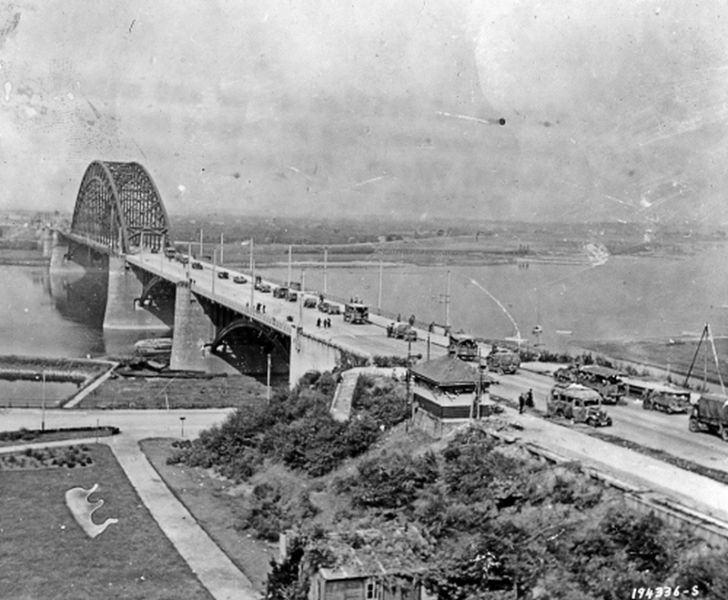 The traffic bridge across the Waal river at Nijmegen after the capture on September 21st 1944. Source: Wilco Vermeer.
The traffic bridge across the Waal river at Nijmegen after the capture on September 21st 1944. Source: Wilco Vermeer.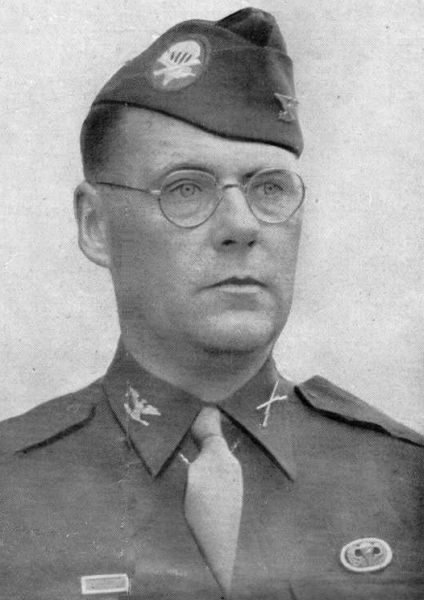 Colonel Roy E. Lindquist Source: Wikipedia.
Colonel Roy E. Lindquist Source: Wikipedia.German defences and American landings
German defence
SS-Gruppenführer (Lieutenant General) Wilhelm Bittrich, commander of the II. SS-Panzer-Korps (armoured corps), who resided with his headquarters in Doetinchem, soon realised that the retention of the Waal bridge could become crucial. By staying in command of the Waal bridge, the British troops would remain isolated and by way of the Waal bridge the Germans would be able to retain the connection between their troops north and south of the Waal river. Already some hours after the Allied landings he assigned the defence of the area around Nijmegen to the 10th SS-Panzer (armoured) division and the area in the vicinity of Arnhem to the 9th SS-Panzer-Division. The unit most stand-by, near Arnhem, the SS-Aufklärungs-Abteilung (reconnaissance unit) 9, under the command of SS-Hauptsturmführer (captain) Victor Gräbner, was ordered to leave immediately from north-Arnhem to Nijmegen to place himself under the command of the 10th SS-Panzer-Division. He also sent Kampfgruppe (assault group) Euling (part of the 2nd Battalion SS-Panzergrenadier (mechanised infantry) Regiment 19 under the command of SS-Hauptsturmführer Karl Heinz Euling) to Nijmegen in order to follow Gräbner and to take on the defence of the Waal bridges. Gräbner's unit of 40 armoured cars passed the bridge at Arnhem around 18:00 hours, approximately one hour earlier before the capture of the bridge by the British under the command of Lieutenant Colonel John Frost would take place.
Arriving at Nijmegen, Gräbner met the men of Kampfgruppe Henke, under the command of Oberst (Colonel) Fritz Henke (Fallschirm-Lehrstab 1 – (Parachute Teaching Staff 1) who, at that time, commanded the defence of Nijmegen and the Waal bridges. Kampfgruppe Henke was, in addition to its own staff (Stab Fallschirm-Ausbildungs-Regiment also Fallschirm-Lehrstab 1), composed of: Ersatz-Bataillon 6, Replacement Battalion 6 (Wehrkreis (military district) VI with 3 companies), Hermann Göring Kompanie (Company) "Runge", a training unit for NCO's and a company of the Ordnungspolizei Rüstungsinspektion (Order Police Armament Inspection) Holland who had to guard the bridges. This defence was supplemented with some Flak units that were mounted as air defence at the railway bridge and the road bridge, two 88 mm Flak of 4. Kompanie, 572 schwere (heavy) Flak Bataillon, five pieces of 47 mm ordnance and 20 mm anti-aircraft guns. Henke had a total of about 750 men at his disposal for the defence of Nijmegen.
In Lent, a village in the vicinity of Nijmegen on the northern bank of the Waal river, the defence was deployed by the Landersschützen Kampfgruppe Assault Group Hartung. From the Betuwe area, the 21. Batterie, SS-Artillerie-Ausbildungs-und-Ersatz-Regiment (21st battery, SS artillery training and replacement regiment), along with the Stabsbatterie und Stab (Staff battery and Staff), under the command of SS-Sturmbannführer (major) Oskar Schwappacher, was sent to Oosterhout (Gelderland) in support and defence of both the Waal bridges. Schwappacher himself established his headquarters near the traffic bridge on the Nijmegen side in the Belvedère, a 15th century watchtower overlooking on the Waal river. Although Gräbner retreated northbound to Elst around 21:00 hrs., where he could send his unit either to Nijmegen or Arnhem, he left one Zug (platoon), (unit of 5 Panzerspähwagen) (armoured scout car) in the vicinity of the Waal Bridge. This unit was going to be withdrawn in the direction of Elst, but before that, skirmishes with American units at the Keizer Karelplein would occur.
Landing on drop zone-T (DZ-T)
The first paratroopers of the 508th Parachute Infantry Regiment (508th PIR) landed on DZ-T ("Dropzone TANGO") at 13:28 hrs on September 17th 1944, just southwest of the hamlet Holdeurn. On their landing, they were met by German flak around the grounds, which they soon managed to eliminate. At 15:00 hrs., 90 percent of the units had assembled and were on their way to their primary objectives. The 1st Battalion was to move towards Nijmegen near the Heilige Land Stichting (Holy Land Foundation) in order to block the access from Nijmegen to Groesbeek. The 2nd Battalion was to occupy the landing area and to organize and defend it. 3rd Battalion had to advance into the direction of the village of Berg en Dal in order to seal off the northern entrances to the landing area. The 1st and 3rd Battalion reached their objectives at 18:55 hrs. and 2nd Battalion at 20:30 hrs. They faced more opposition.
One of the tasks of the 508th PIR was safeguarding the northeast side of the landing area for the purpose of the upcoming landings of the gliders and the organisation of the defense there. If the situation around the landing area would allow it, Colonel Lindquist could act as he saw fit and direct a battalion to Nijmegen with the aim of taking the road bridge over the Waal river. For this purpose, 1st Battalion, 508th PIR, under the command of Lieutenant Colonel Shields Warren was appointed. At 18:30 hrs., the 1st Battalion had entrenched itself at “The Ploeg”, (The Plough) southeast of Nijmegen in the vicinity of the Holy Land Foundation, to repel any attacks from the direction of Nijmegen to Groesbeek. Company A and B of the 1st Battalion formed the MLR (Main Line of Resistance) whereas C Company was held in reserve.
While A and B Company dug in on their line, a combat patrol of C Company, commanded by Lieutenant Robert Weaver, was sent in the direction of the Nijmegen road bridge to reconnoitre the German defences. In case the bridge happened to be un- or only lightly defended, he should capture and secure it immediately. Of this combat patrol some men were able to reach the bridge before the arrival of Gräbner. They took the German defenders prisoner and controlled the access to the bridge on the south side for a short time. It took too long, however, for reinforcements to arrive and since their strength was insufficient for a successful stand, the patrol left its position without their prisoners, the moment they heard the swelling rumble of heavy vehicles – the column of Gräbner – and retreated towards De Ploeg.
At 20:00 hrs. Lieutenant Colonel Warren received the command of Colonel Lindquist to take the road bridge instantly with 1st Battalion. When Gavin had been informed at 18:00 hrs. that no attempt had yet been made to take the Waal Bridges, he immediately directed Colonel Lindquist to do so. A Dutch resistance fighter, Geert van Hees, had informed Gavin that at that time the road bridge was guarded merely by a petty officer with 17 men. The resistance fighter was to accompany the 1st Battalion as a guide. Around 20:00 hrs. Gräbners units arrived on the south side of the bridge.
Definitielijst
- Abteilung
- Usually part of a Regiment and consisting of several companies. The smallest unit that could operate independently and maintain itself. In theory an Abteilung comprised 500-1,000 men.
- Flak
- Flieger-/Flugabwehrkanone. German anti-aircraft guns.
- infantry
- Foot soldiers of a given army.
- Kampfgruppe
- Temporary military formation in the German army, composed of various units such as armoured division, infantry, artillery, anti-tank units and sometimes engineers, with a special assignment on the battlefield. These Kampfgruppen were usually named after the commander.
- paratroopers
- Airborne Division. Military specialized in parachute landings.
- Regiment
- Part of a division. A division divided into a number of regiments. In the army traditionally the name of the major organised unit of one type of weapon.
- Resistance
- Resistance against the enemy. Often also with armed resources.
Images
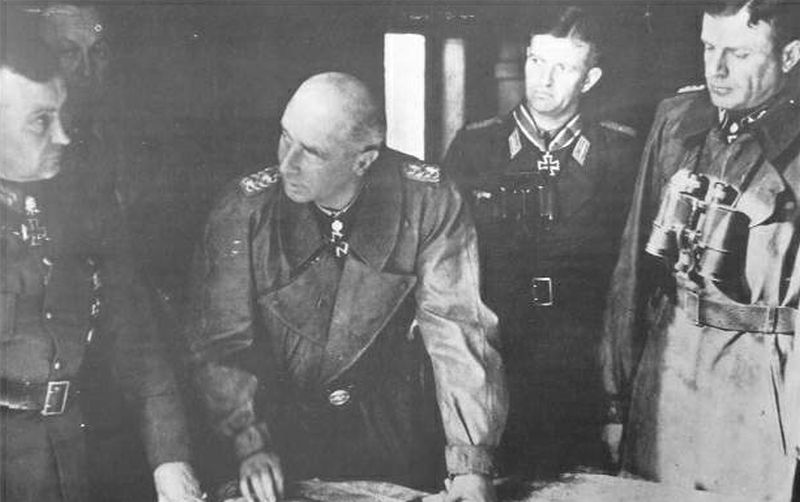 Model, Bittrich, Knaust and Harmel (left to right) during a meeting at the time of Operation Market Garden. Source: Wilco Vermeer.
Model, Bittrich, Knaust and Harmel (left to right) during a meeting at the time of Operation Market Garden. Source: Wilco Vermeer.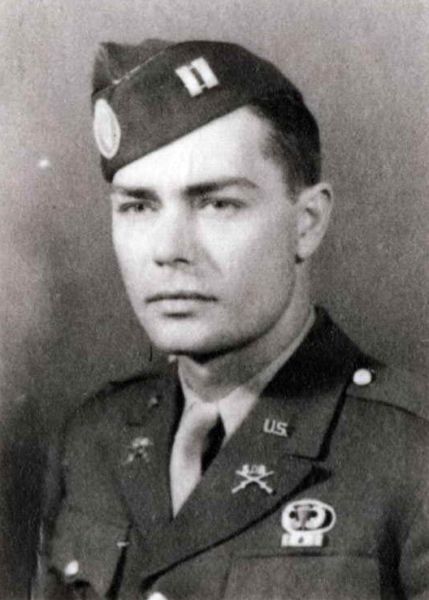 Lieutenant Colonel Shields Warren Source: Find a Grave (Dick O’Donnel).
Lieutenant Colonel Shields Warren Source: Find a Grave (Dick O’Donnel).The attack
Following consultation with Geert van Hees, Colonel Warren decided to follow the main road from Groesbeek to Nijmegen and then deflect on the Keizer Karel Square eastward to attack the bridge. After determining the route, he gave the order to his company-commanders to proceed. A Company however, commanded by Captain Jonathan E. Adams, was not yet complete at that time. He was given the Machine Gun Section of Battalion Headquarters Company as a support. In the meantime Battalion Headquarters settled in the woods near the Heilige Land Stichting. At 20:30 hrs. A Company advanced in the direction of the IP (Initial Point) but still had to wait for B Company.
C Company received directions to keep the positions at ’De Ploeg’ occupied. At 22:00 hrs. Adams was ordered to advance. Initially, this succeeded without too much opposition. However, when the vanguard of the 1st Platoon approached the intersection of the Groesbeekseweg with the Fransestraat, it was met by German machine gun fire. The platoon Leader got wounded hereby and his Assistant Platoon Leader was killed. While seeking cover within the ranks of A Company, further in the rear, still on the Nijmeegsebaan, Corporal Roy B. Lewis was killed. While ducking away into a foxhole he hit the bayonet of another para, which slashed an artery in his leg. Although he managed to drag himself out of the foxhole, he bled to death in the garden of no. 68 Nijmeegsebaan.
2nd Platoon, commanded by Lieutenant George D. Lamm, was sent through the line of 1st Platoon. From there they allowed Geert van Hees to cooperate with Scout Private Walter Dikoon.
Near the intersection with the road to Mook (St. Annastraat) the column was again held up by a German machine gun, but they managed to eliminate this one too, whereupon the troops approached the Keizer Karelplein (Emperor Charlemagne Square). The Dutchman Geert van Hees now was sent away to guard him against further danger.
Arriving at the Keizer Karelplein scout Walter Dikoon came under fire of a German machine gun from the park in the middle of the Keizer Karelplein which killed him. On this, 2nd Platoon Leader Lieutenant Lamm brought two Bazooka Teams forward and made his men to occupy assault positions opposite the square. At that very moment a German half-track drove forward with SS-Grenadiers. An exchange of fire and man-to-man combat ensued. Lieutenant Colonel Warren ordered A Company to capture the Keizer Karelplein itself and to seal off all access roads from the west. The attack very soon stalled in a barrage on the Keizer Karelplein, after which A Company withdrew in the buildings around the southern part of the square. During the fighting at the Keizer Karelplein Private Ray M. Johnson was killed near the spot where Walter Dikoon fell.
The Germans occupied the buildings on the north side and dug in along both sides of the Oranjesingel (Orange Canal) at the entrance to the square. On this, B Company, under the command of 1st. Lieutenant Woodrow W. Millsaps, was sent forward to continue the attack on the right. This attack too, stalled along the Oranjesingel on German resistance (later on, Millsaps would receive the Silver Star Medal, among other things for his action).
Next they made B Company to pin down the German defenders, while A Company tried to pull up from the right towards the bridge. A Company was able to approach the bridge up to 350 meters. During the assault on the Keizer Lodewijkplein (Emperor Louis Square), at the entrance to the bridge, Staff Sergeant Alvin H. Henderson was killed. During the advance he personally killed German soldiers, destroyed machine gun positions and took prisoners. For these efforts, he was honoured posthumously with the Distinguished Service Cross.
A patrol of 2nd Platoon, commanded by Captain Jonathan E. Adams Jr. and First Lieutenant George D. Lamm, was sent to the post office, about halfway between the Keizer Karelplein and the bridge. During the skirmishes around the Keizer Karelplein they managed to sneak past the German lines with a small patrol. They did that in order to investigate what was true of the report from the resistance that detonators were installed in the post office for blowing up the road bridge. After fierce fighting, they managed to occupy the post office and to demolish some objects who possibly had to serve for this purpose. Due to German counterattacks the patrol could not get away and they managed to hold out for three days in a shop on the corner of the Lange Hezelstraat and Jodenberg. (Adams and Lamm received the Silver Star Medal for their share in this action.
The resistance at the bridge was so severe that A Company had to withdraw to the positions of B Company, who in the meantime had managed to reach a park in the vicinity of the Keizer Lodewijkplein, whereby the first attempt to take the Waal bridge had, in fact, stalled and could be considered a failure. The German defences at the bridge proved to be too strong for 1st Battalion 508PIR. The German defenders then set fire on numerous buildings to prevent attempts for attacks in the darkness.
Definitielijst
- bayonet
- Pointed weapon that can be placed at the end of a rifle and used in man-to-man combat.
- Bazooka
- American antitank rocket launcher weapon. Rocket with shaped charge is put in a long tube which is electrically fired from the shoulder of an infantry man. The bazooka can be reloaded. The bazooka produces a large flame to the rear which makes it unsuitable for fighting from closed compartments or from homes. British counterpart is the PIAT, Projector Infantry, Anti- Tank, also a man-portable anti-tank weapon. Germany used Panzerfaust and Panzerschreck, “armour fist “ and “armour terror”.
- Machine Gun
- Machine gun, an automatic heavy quick firearm.
- resistance
- Resistance against the enemy. Often also with armed resources.
Images
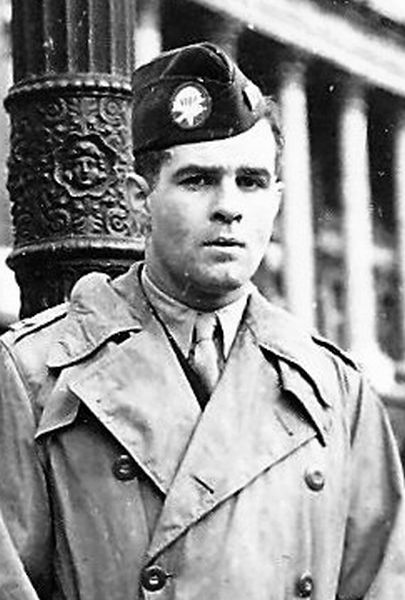 Captain Jonathan E. Adams, Co, A Company. Source: 508th Parachute Infantry Regiment.
Captain Jonathan E. Adams, Co, A Company. Source: 508th Parachute Infantry Regiment.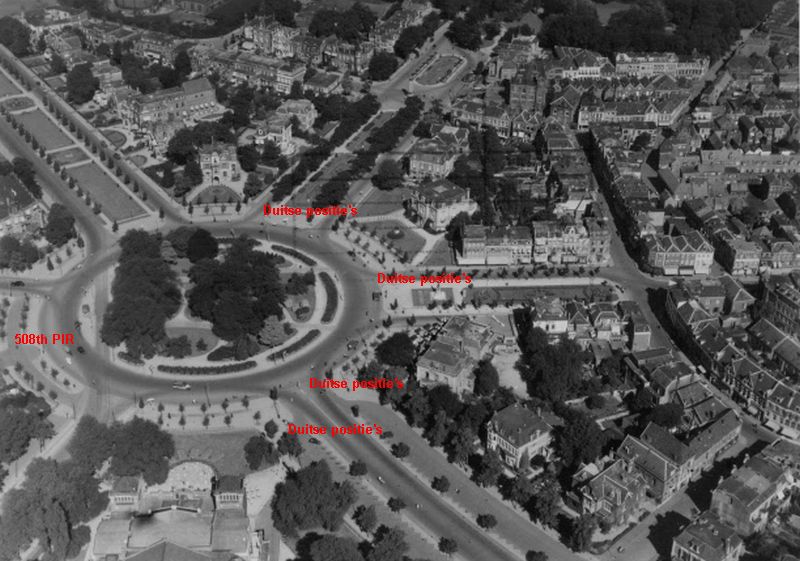 Keizer Karel Square, with roughly the positions of 508th PIR and the German defenders. Source: Wilco Vermeer.
Keizer Karel Square, with roughly the positions of 508th PIR and the German defenders. Source: Wilco Vermeer.Back to Groesbeek and further course
Back to Groesbeek
Later on, the 1st Company of the 508 Parachute Infantry Regiment was forced to withdraw to regroup for another attack. At 08:00 hrs. on September 18th, C-Company was ordered to proceed towards Groote Vlierenberg for a counterattack on the German forces that threatened the landing area at Groesbeek with a strike from the direction of the Reichswald. A-Company regrouped, supplemented by an 81 mm Mortar Platoon Squad at The Ploeg, in support of counterattacks at the landing zone or, if the situation would allow it, a renewed attack on the bridge in cooperation with G-Company, 3rd Battalion. Around midnight 17/18 September, G-Company had been ordered to undertake a second attack on the Waalbridge. Meanwhile, B-Company had to protect the conquered positions at the Keizer Lodewijkplein.
From the vicinity of Wyler, a German village just across the border, units of the German 406 Landesschützen-Division (conscripts of 35-45 years of age) had advanced in the direction of the landing areas. This division consisted mainly of administrative and training units. The division had been mobilized and sent to Nijmegen within six hours after the American Airborne landings took place. Early in the morning of Sept. 18th, they had managed to make a ‘Korps Feldt’ of about four battalions of mixed units under the command of General Kurt Feldt, ready for the attack in the Nijmegen area. At 6:30 hrs. pm they attacked the American bridgehead: Eventually, 2300 troops, backed by five armoured vehicles and three half-tracks with 20mm Flak guns advanced at 10:30 hrs. in the direction of the American lines, between Groesbeek and Beek. Korps Feldt consisted of units of the 406. Landesschützen-Division “Scherborning” and units of ‘Wehrkreis’ (military district) VI. It was during this confusion that Gavin was forced, around 11:00 hrs., to recall the entire 1st Battalion 508th PIR to the landing grounds. After regrouping at Groote Vlierenberg, meanwhile secured by C Company, the 1st Battalion attacked around 12:30 hrs. They arrived in time to take action, as German troops held the landing area under fire right at the moment the gliders were about to land.
Further course
The first attempt to capture the road bridge across the Waal at Nijmegen had failed. During the days that followed on September 17th, two other attempts would be made (on 18 and 19 September) before, on September 20th, the 504th Parachute Infantry Regiment and the Guards Armoured Division could capture both the railway and traffic bridge across the Waal in a joint operation. This allowed the allied forces from September 21st onwards to advance further into the Betuwe in an attempt to reach the Poles (1st Polish Independent Parachute Brigade) who landed at Driel and the British (1st Airborne Division) who landed at Arnhem. The Poles could be reached, but the situation of the 1st Airborne Division had so deteriorated that the decision had to be taken to end the Market Garden operation on September 25th and to evacuate the 1st Airborne Division. Arnhem proved to be a ‘bridge too far’.
Definitielijst
- Brigade
- Consisted mostly of two or more regiments. Could operate independently or as part of a division. Sometimes they were part of a corps instead of a division. In theory a brigade consisted of 5,000 to 7,000 men.
- Flak
- Flieger-/Flugabwehrkanone. German anti-aircraft guns.
- Infantry
- Foot soldiers of a given army.
- Mortar
- Canon that is able to fire its grenades, in a very curved trajectory at short range.
- Regiment
- Part of a division. A division divided into a number of regiments. In the army traditionally the name of the major organised unit of one type of weapon.
Images
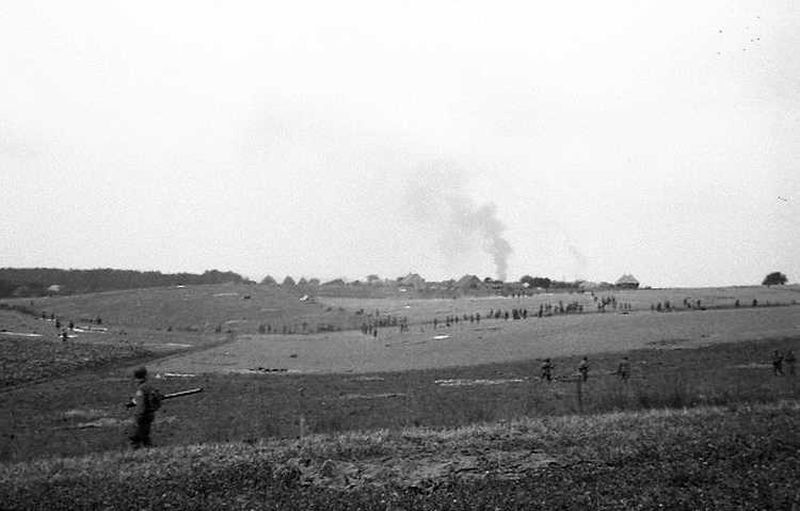 Men of 508th PIR clear the landing zone for the arrival of the gliders. Source: 508th Parachute Infantry Regiment.
Men of 508th PIR clear the landing zone for the arrival of the gliders. Source: 508th Parachute Infantry Regiment.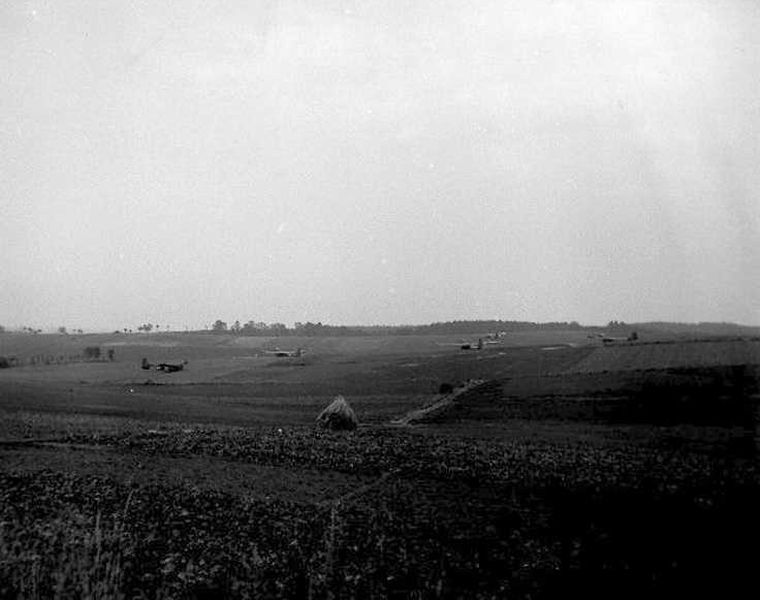 Gliders are landing on Landingzone-T (LZ-T). Source: 508th Parachute Infantry Regiment.
Gliders are landing on Landingzone-T (LZ-T). Source: 508th Parachute Infantry Regiment.Information
- Article by:
- Wilco Vermeer
- Translated by:
- Cor Korpel
- Published on:
- 11-02-2017
- Last edit on:
- 30-09-2024
- Feedback?
- Send it!
Related books
Sources
- BERENDS, P., Een andere kijk op de Slag om Arnhem, Aspekt, Soesterberg, 2003.
- HOLT, T. & HOLT, V., Operation Market Garden, Leo Cooper, Barnsley, 2001.
- LORD, W.G., History of the 508th Parachute Infantry, Infantry Journal press, Washington, 1948.
- LYNCH, T., Operation Market Garden, Spellmount Publishers, Stroud, Great Britain, 2011.
- NORDYKE, P., All American All the Way, Zenith Press, St. Paul, United States, 2005.
- SAUNDERS, T., Nijmegen: US 82nd Airborne & Guards Armoured Division, Pen & Sword Books Ltd, Barnsley, 2001.
- ZALOGA, S. J., The Siegfried Line 1944-45, Osprey Publishing Ltd., Oxford, United Kingdom, 2007.
- A Historical Study of Some World War Two Airborne Operations, WSEG Staff Study No. 3, 20 February 1951
- Cooper, Kenneth W., The 508th Parachute Infantry Regiment, Leadership LO6, 3 March 2006
- Gavin, James M., A Graphic History of the 82nd Airborne Division, Operation "Market", Holland 1944
- Field Order No. 11, Headquarters 82nd Airborne Division, 13 September 1944
- WO18-R-13333, 21 Army Group, Operation "Market Garden" 17-26 September 1944, 2 February 1948
- R-11376, Narrative of Market Operation, General Brereton, 1944
- Headquarters, 508th Parachute Infantry, After Action Report, APO #230, U. S. ARMY, 7 December 1945
- Weergave getuigenis Captain Chester E. Graham
- Oorlogsdoden Nijmegen
